I've been reflecting on my audio writing of late, as I've recently arrived at the milestone of 1000+ articles published here at Jeff's Place, as well as 79 feature articles for Positive Feedback, and before that 52 articles for Six Moons.
You can find links to my Positive Feedback and Six Moons articles under my Jeff's Pages links at my Archives link (HERE).
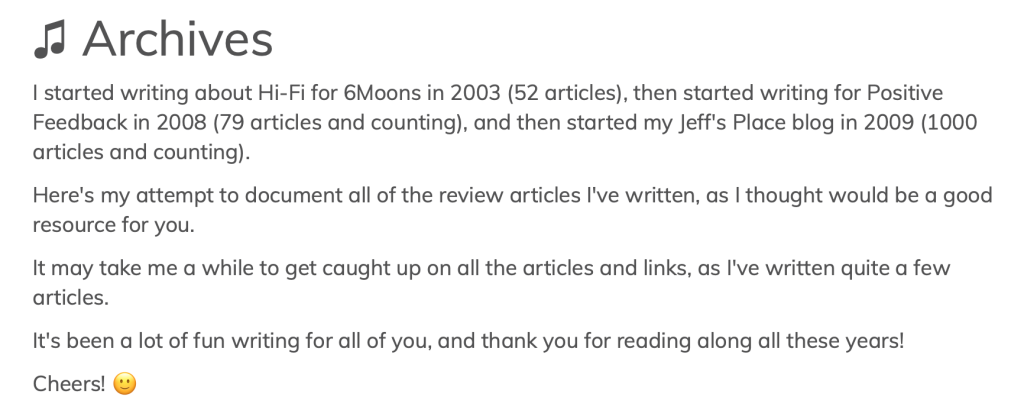
Alas, the Archives link does not document all of my Jeff's Place articles, although you can peruse those articles by scrolling down to the bottom of the main Jeff's Place home page featuring Recent Articles (HERE), and then click the Next Page link for more past articles.
Paul James, author of Experiencing Gigli with Quality Audio, made a timely suggestion for an article (Thanks, Paul!):
"Hi Jeff, I was thinking given you have reached the huge 1000 article milestone, it would be interesting to have a reflection piece on what’s it’s taken to do all those reviews and any thoughts arising from the overall journey."
What It's Taken To Do All Those Reviews
First of all, to do all those audio reviews took a lot of time. Time to select suitable components for review, time to let audio components run-in, time for optimizing system setup to get audio components performing at their best, time for listening, time for interviewing, time for photos, and time for writing.
It all adds up - it's a lot of time.
It's also been a lot of fun, and it has really been illuminating interviewing the creative forces of audio over the years, like the late Don Garber (Fi), Taku Hyodo (Leben HiFi Stereo Company), Keith Aschenbrenner (Auditorium 23), Tom Evans (Tom Evans Audio Design), Gordon Rankin (Wavelength Audio), Ken Ishiguro (Acoustic Revive), Dr. Paul Mills (Tannoy), Mark Coles (Sablon Audio), Richard and Sue Wugang (Sophia Electric), Frederick Carøe (Duelund Coherent Audio), Shirokazu Yazaki (Spec Corporation), Nelson Pass (First Watt and Pass Labs), Wayne Colburn (Pass Labs), Peter Qvortrup (Audio Note (UK)), Andy Grove (Audio Note (UK)), Darko Greguras (Audio Note (UK)), Frank Ng (Triode Lab), Pete Riggle (Pete Riggle Audio Engineering), Daisuke Asai (Murasakino Musique Analogue), Peter Ledermann (Soundsmith), Jaap Pees (Hanze HiFi), and the many others I've interviewed over the years.
When I really want to know what's important in audio, or within a particular audio design philosophy, I talk to the designers and manufacturers. They all have their particular expertise, philosophy, and perceptions about how to get the most out of our audio hobby, and I really value their expertise and opinions.
As audio hobbyists, we all have our particular interests and preferences when it comes to audio, and when I select components to write about, they reflect that.
At the same time I try to keep an open mind, and listen to components that are outside of my usual wheelhouse, which can be illuminating and rewarding.
Over the years I've tended to gravitate towards large horn loudspeakers, vacuum tube electronics, and analog sources. Those choices are not for everyone, I just happen to like the way they play recordings of music.
However, getting out of my usual interest areas to listen to monitor-style loudspeakers, solid-state electronics, and digital sources has been immensely rewarding and illuminating. I learned that I also liked the way they play music, and that there are benefits to all those approaches to audio.
For example, over the last few years I've learned how important (for me at least) having a CD player is, as it allows me a convenient way to listen to recordings from all of the eras of the recording arts. I also found out that digital playback has advanced dramatically since its rather disappointing debut phase.
Home audio has evolved in a lot of different directions since the first recordings of music became available, circa 1877, and people have found a lot of different ways to enjoy listening to music in the comfort of their own home.
My view is that it's ok to like what you like, and to enjoy the audio hobby in whatever way you want to.
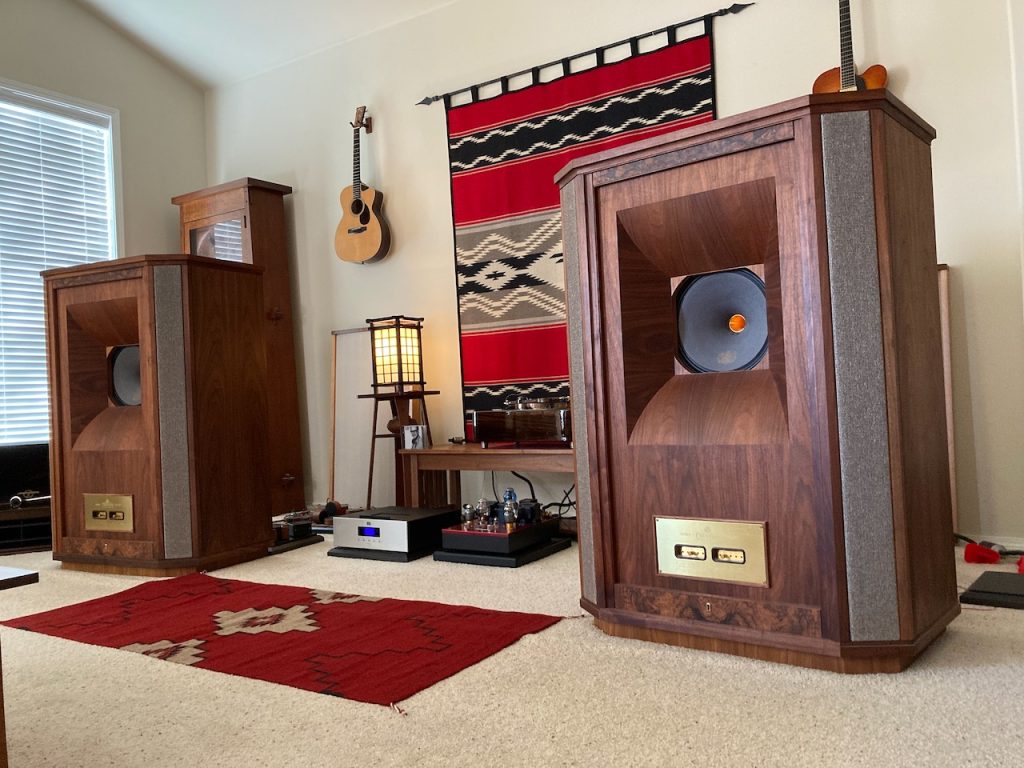
Tannoy Westminster Royal SE loudspeakers based music system.
Over the years my involvement in the audio hobby has led me to put in place a number of audio systems for different purposes. I have an audiophile-style music system (above).

My vintage Altec A5 Voice of the Theatre loudspeakers based audio-visual system.
I have a vintage inspired audio-visual system (above) based on vintage Altec A5 Voice of the Theatre loudspeakers, a restored vintage Thorens TD-124 turntable, and at this very moment, the Audio Note (UK) Meishu Phono Silver Tonmeister 300B SET integrated amplifier that is in for review.
Just yesterday I had an audio gathering at my place, and part of the time was spent listening to the classic small to mid-sized American movie theater combination of the vintage Altec A5 Voice of the Theater loudspeakers powered by 300B amplification.
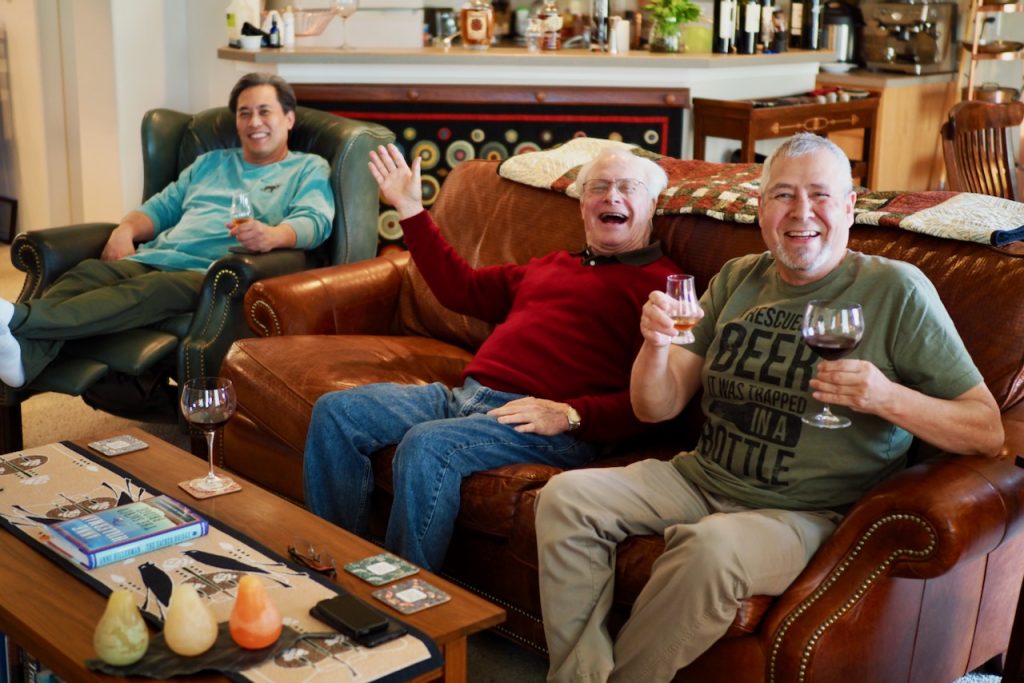
Left to right: Friends Doc Leo, Ron, and Santos at Jeff's Place.
While Western Electric 91A amplifiers were part of the classic A5 and 300B magic combination back in early movie theater days, we were wowed by the much higher performing Meishu integrated amp with the Altec A5s, which blew us away with its refinement, resolution, and spaciousness while we watched a portion of Woody Allen's Midnight In Paris, which was loosely based on Ernest Hemingway's A Movable Feast, with a bit of time travel thrown in for a fun and imaginative story line.

Audio Note (UK) music practice system.
I recently installed an Audio Note (UK) Level 2 system as a 'music practice system' in my guitar room / office to aid me in learning to be a better guitarist (above).
During our little audio get together yesterday, we also took time to listen to this combination of Audio Note (UK) AN-K loudspeakers, Audio Note (UK) Oto Phono SE Signature integrated amplifier, Audio Note (UK) CD 2.1x/II Level Two Red Book CD Player, Sablon Audio power cords, Duelund DCA16GA speaker cables, and Belden 8402 microphone cable interconnects.
Each visiting listener - all hard-core audiophiles - who sat in the near-field listening position and heard the performance of this system, with its room boundary positioning of the AN-K loudspeakers, remarked about how spacious and naturally musical the system sounded, and what a remarkable accomplishment it was to get this level of performance in a smaller room.
A tip of the hat towards Brighton, England, to Peter Qvortrup, and all the Audio Note (UK) family, that have developed such remarkable high-performance audio kit for us to listen to.
The superbly refined performance of this Audio Note (UK) system makes this an ideal system for someone who lives in a smaller space, or wants to have an unobtrusive high-performance audio system in any living space.
Maximum musical performance in combination with maximization of living space due to the room boundary positioning of the loudspeakers, will be the perfect high-fidelity listening solution for a lot of listeners, I suspect.
I might add that the AN-K loudspeakers are not even close to their Audio Note (UK) owner's manual recommendation of 200 hours for being fully run-in yet, and I haven't even started to optimize their positioning yet, and this system still sounded remarkably good.
I will write much more about this Audio Note (UK) system that is in for review, both in upcoming posts in the near future, and in the feature article for Positive Feedback that will follow at a later point in time. Please wait for it.

Vintage Altec Corona 832A loudspeaker.
I also have a bedroom audio-visual system based on vintage Altec Corona 832A loudspeakers (above), which I am in the midst of getting setup with Pass Labs and First Watt components, about which I will have much more to say in the not too distant future.
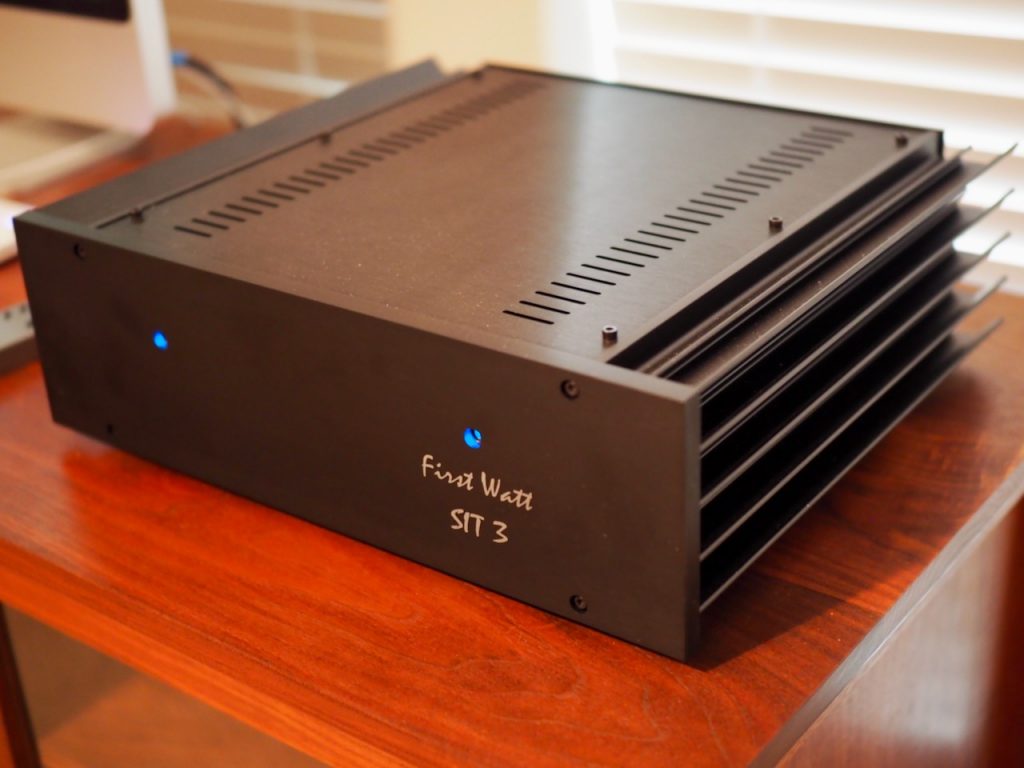
First Watt SIT-3 stereo amplifier.
I know, my approach to the audio hobby is geek city squared. Sure is a lot of fun though!
I suppose I could be practical and try to make one audio system do it all, but I enjoy having several different systems around for different purposes, and aside from just being a lot of nerdy audio fun, its useful for my audio writing hobby here at Jeff's Place and Positive Feedback.
For example, with multiple audio systems I can have audio components getting run-in time in a particular system, while writing a review of a fully run-in audio component in a another audio system.
I can get more audio components written about with multiple parallel systems in operation, than I can with just one system, where I am limited to writing about components in series.
Multiple systems also gives me a better idea if a given component 'plays well with others'. All components are affected by the other components in a system, and seeing how a component's performance fares in a variety of contexts can provide useful information.
Speaking of run-in time, over the years I've found it really takes longer to run-in components than I originally thought.
I used to think 100 hours of run-in time was enough, but on average, I have found that it takes more like 200 hours of run-in time for most components, and for some components it takes even longer.
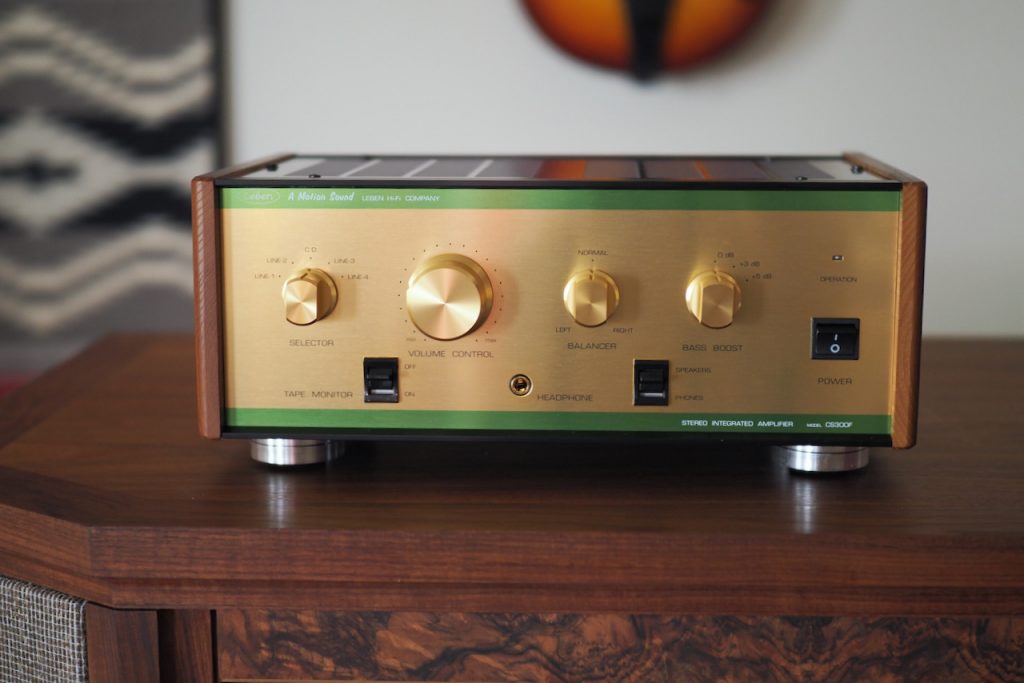
Leben HiFi Stereo Company CS-300F integrated amplifier
The Leben Hi-Fi Stereo Company CS-300F vacuum tube integrated amplifier (above) took a whopping 600 hours before it started to settle down and sound its considerable best in my audio-visual system!
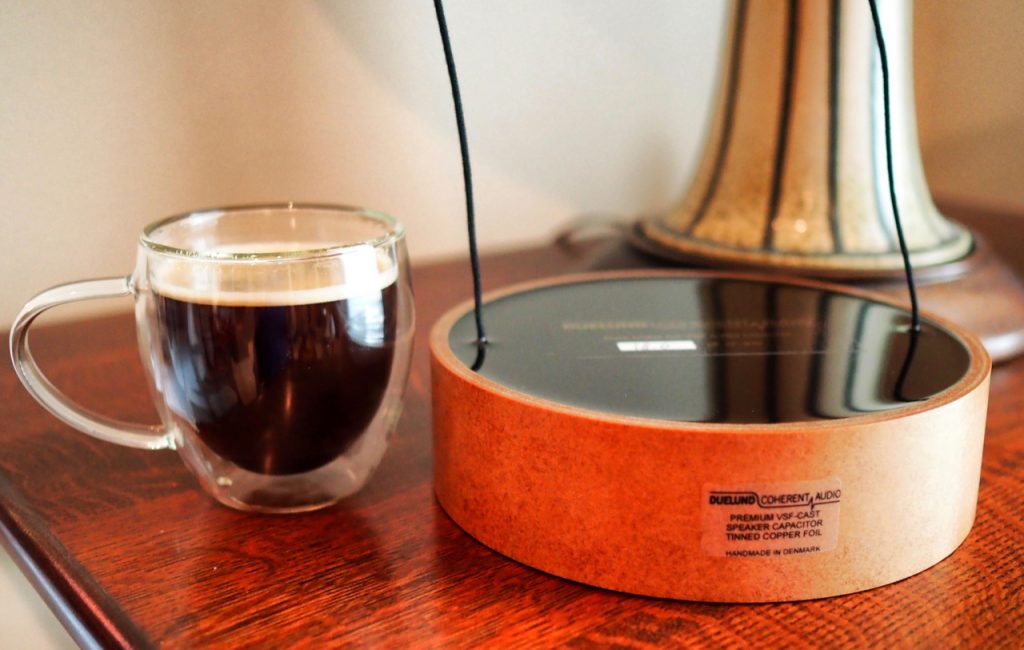
18uF Duelund CAST Sn-Cu capacitor at C1 in my Altec crossovers, with an 8 oz. coffee cup for a size comparator.
As an aside, some components, like the hand-crafted ultra-performance Duelund Coherent Audio CAST capacitors, inductors, and resistors, start out sounding great, then continue to improve in terms of refinement for years.
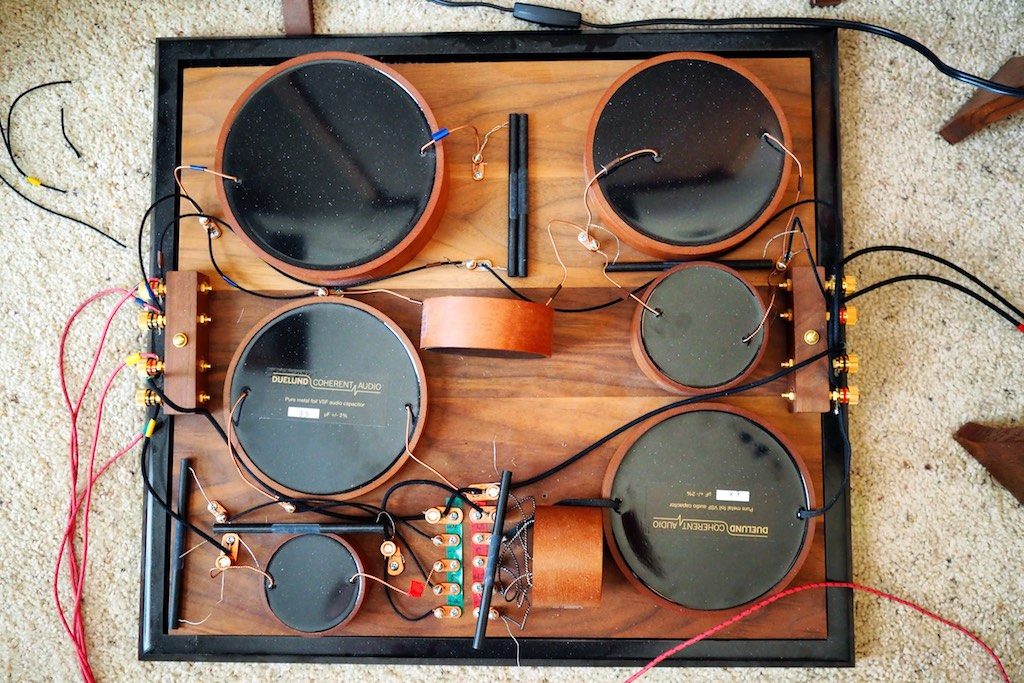
Duelund CAST crossover for Tannoy Westminster loudspeaker.
The Duelund CAST crossovers for my Tannoy Westminster Royal SE loudspeakers (above) have nine years of playing time on them now, and they're still revealing subtle refinements to me over time.
The moral of the story is that components can change rather dramatically in sound quality and musicality over the course of the run-in process, so if what you hear with that new component isn't quite what you were expecting, be patient and wait until you hit at least the 200 hour mark before you make any judgements.
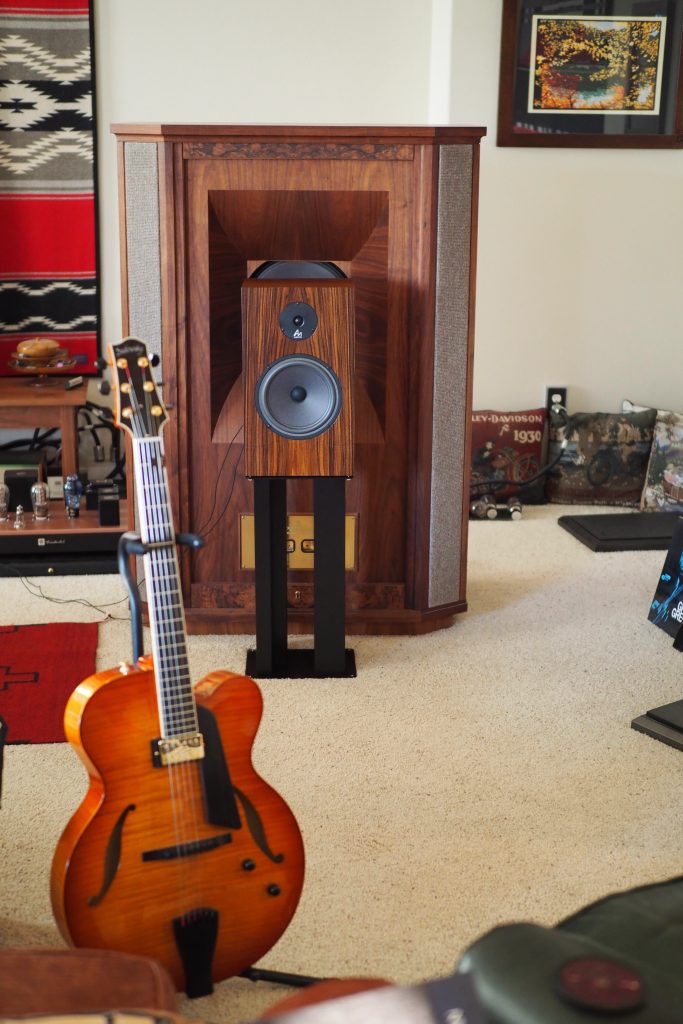
Audio Note (UK) AN-K/SPe loudspeaker atop AN-J loudspeaker stand (front), Tannoy Westminster Royal SE loudspeaker (rear).
I have found loudspeakers to be my 'anchor components' to build systems around. Loudspeakers have the most influence on the sound you hear, and have the biggest influence on which associated components will be the most suitable for getting the best performance out of them.
My recommendation for building a system is that you first choose a pair of loudspeakers that best fits your living space, and that you really enjoy listening to from a musical perspective, and then pick out the associated system components that best complement them.
My second recommendation is that you try to stick with components from the same manufacturer if you can, as they are all designed to work together in complimentary fashion, and that makes life a lot easier for building a system and getting a good result.
Some manufacturers, like Audio Note (UK), for example, build everything for an audio system from source to loudspeakers, which makes life easy when assembling a system, and you know it's going to sound great when you've put it together due to design synergy.
As with the Level 2 Audio Note (UK) system described above, this sort of design synergy using components from the same manufacturer results in a lofty level of performance that you would be very hard pressed to match with a mix & match component approach utilizing components from multiple manufacturers.

Pass Labs and First Watt!
Another example of system synergy in choosing components is Nelson Pass' Pass Labs and First Watt components, which are a great match to my Tannoy Westminster Royal SE loudspeakers, and I love their sound quality and the way they play music through my Westminsters.
Tannoy Westminster Royal SE loudspeakers can be really fussy to match components to, but when you get the associated components right, they are amazing to listen to music with.
So why are my Tannoys such a good match to Pass Labs and First Watt components?
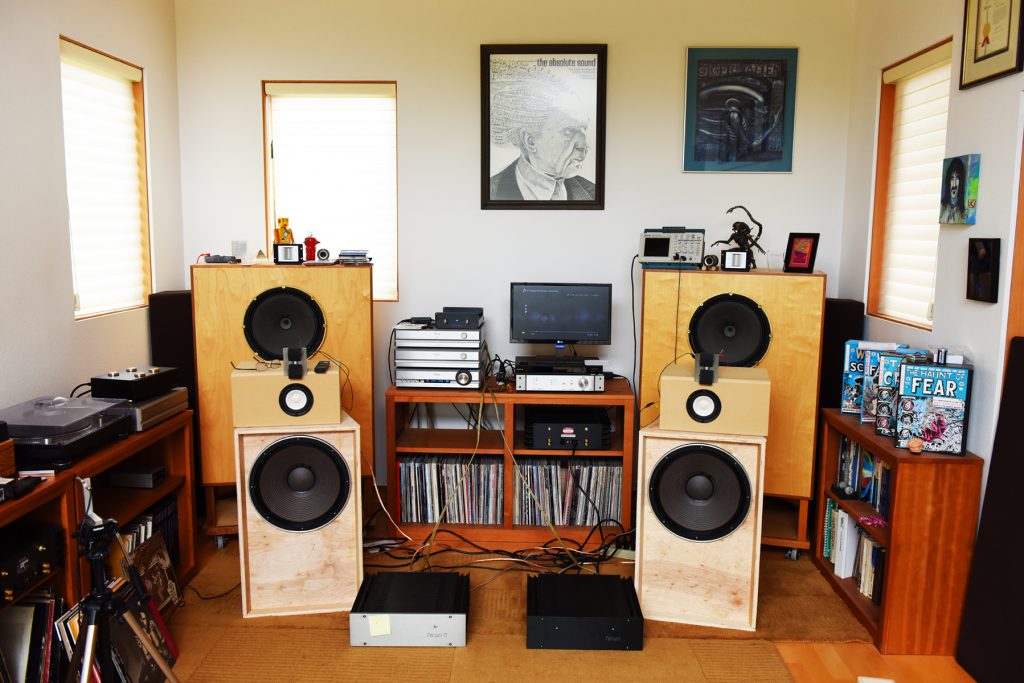
Nelson Pass' home system. Note the Tannoy dual concentric drivers in the custom cabinets. Photo by David Robinson.
That's easy. The reason is that Nelson and Wayne Colburn both use 15-inch Tannoy dual concentric drivers in custom cabinets as part of their electronics development and voicing process, and as a result Pass Labs and First Watt components are an exceptional match to Tannoy dual concentric drivers like those that I have in my Westminsters.

Triode Lab 45 SET 'EVO' integrated amplifier.
It also turns out that the 2 watt Triode Lab 45 EVO SET integrated amplifier is a fantastic match to my Westminsters. Stunning, really.
Why? It's because Frank Ng knows how to voice the build of his custom Triode Lab 45 EVO SET integrated amplifiers to complement particular high-sensitivity loudspeakers. Frank uses hand selected components, like Hashimoto transformers, super-quality circuit components like resistors and capacitors, and vacuum tubes, etc., that he knows from experience will best match a customer's loudspeakers for the maximum performance. The result is an SET amplifier that is built to get the best out a particular set of loudspeakers, like my Westminsters, for example.
A custom build, like the 45 EVO integrated amplifier available from Triode Lab, maximizes the component synergy principle to achieve the highest level of performance when building a system around a particular pair of loudspeakers.
Along those same lines of optimizing a component build, often the DIY guys have great sounding systems.
The reason is they can swap in and out circuit components in their loudspeakers and electronics, like resistors, capacitors, inductors, transformers, and so forth, until they find the perfect voicing for their audio system and personal tastes.
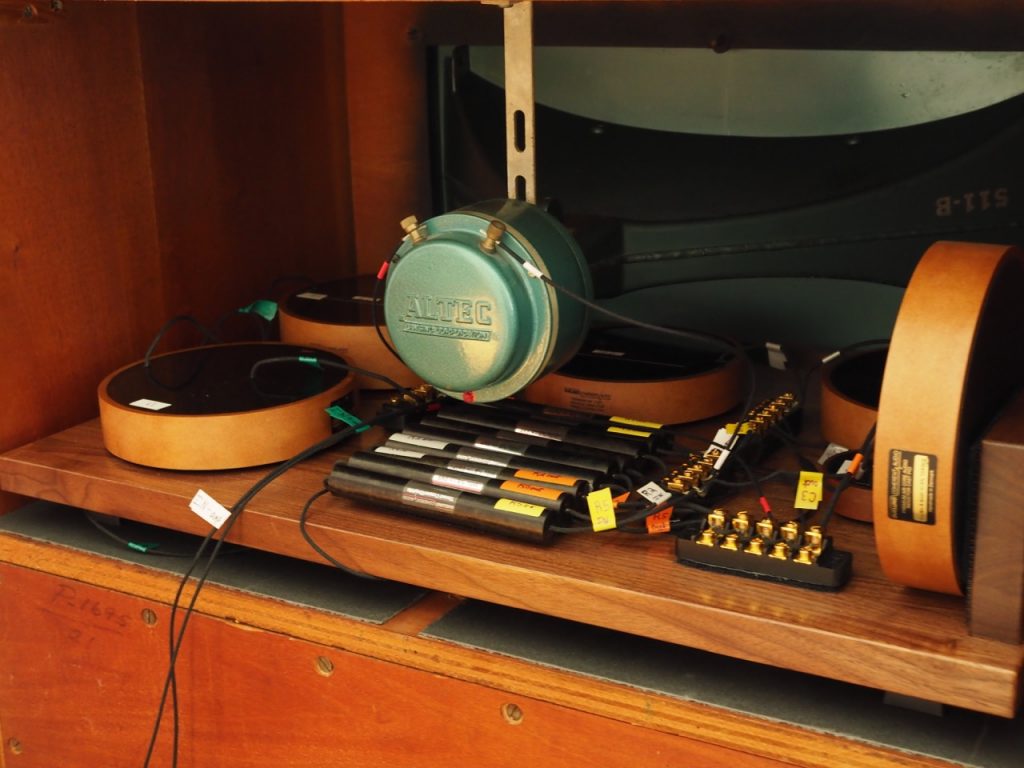
Duelund CAST tinned-copper crossovers in the "Stokowski" Altecs. loudspeakers.
I've built custom Duelund crossovers for both my Westminsters and my vintage 'Stokowski' Altecs (above), and being able to use premium parts to get the voicing just right is a huge advantage for loudspeaker performance.
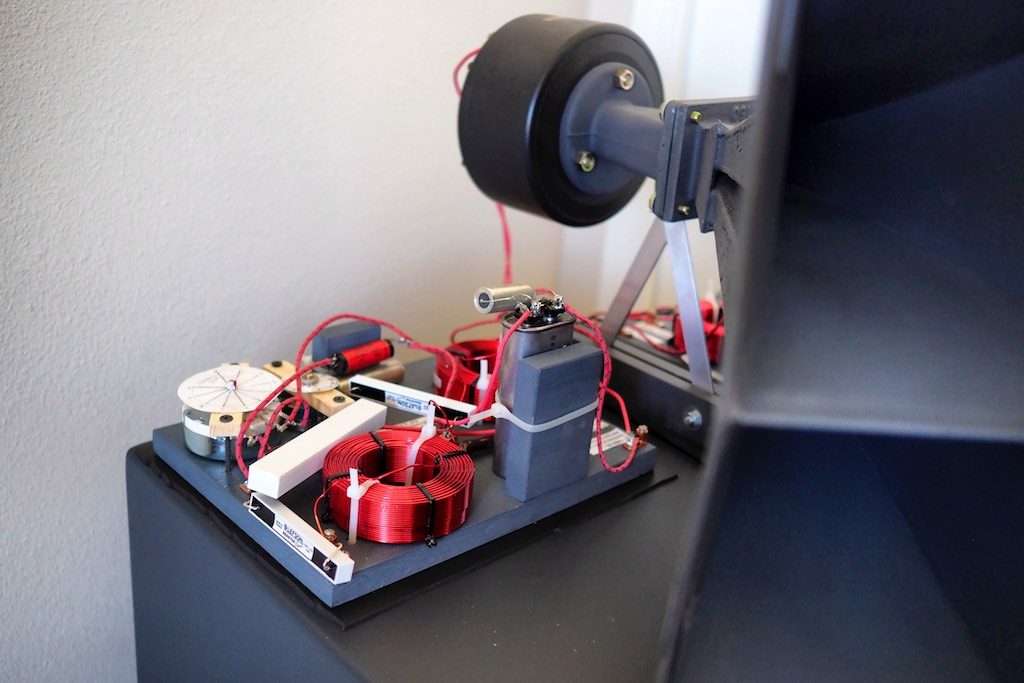
Altec A5 crossovers.
I also built crossovers for my vintage Altec A5 Voice of the Theatre loudspeakers. For the A5s I used more budget oriented components, but the ability to mix and match the components until I found the voicing I wanted resulted in some great sounding loudspeakers for my audio-visual system.
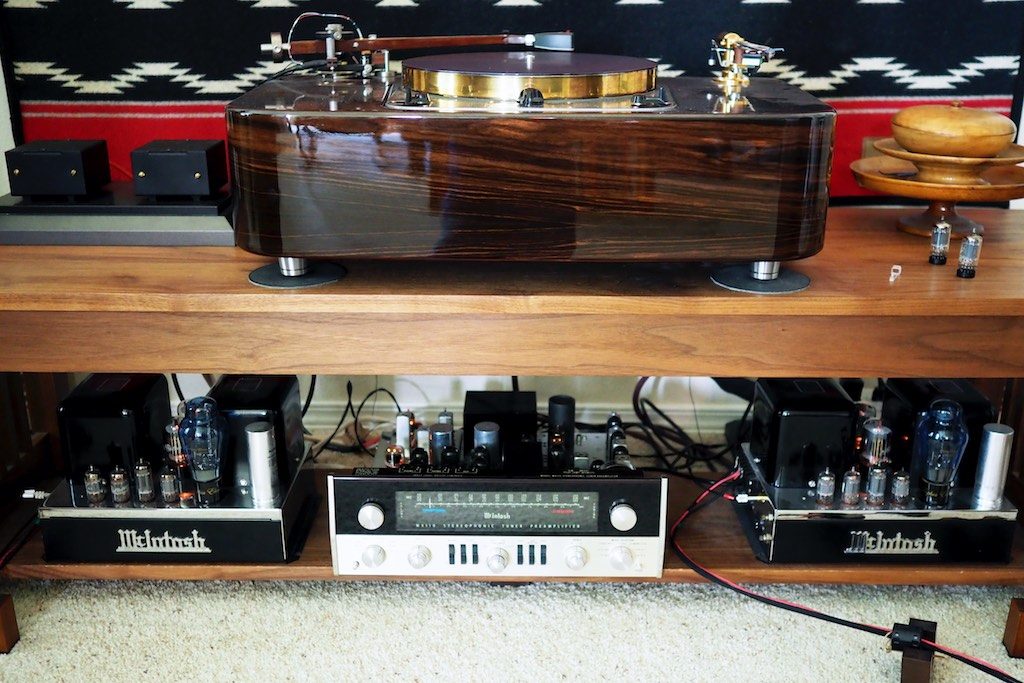
Hot-rodded Vintage McIntosh MC30 monaural amplifiers, and vintage McIntosh MX110Z preamplifier.
For my vintage McIntosh MX110Z preamplifier and MC30 monaural amplifiers, friend Yazaki-san guided me in some DIY capacitor and resistor upgrades that dramatically improved their performance, and at the same time allowed me to voice them to best match to my Westminsters.
Most of us audio nuts can't go the full DIY route of tailoring performance perfectly to our tastes though, so instead we have to choose our components wisely.
Another key principle for putting together a great sounding system is to simplify.
Mixing and matching components from different manufacturers only occasionally works out in providing excellent performance, and that mix & match approach to building an audio system has resulted in more than one frustrated audiophile abandoning the hobby.
However, if you can simplify your audio system it can pay big dividends in getting your system performing the way you want it to.
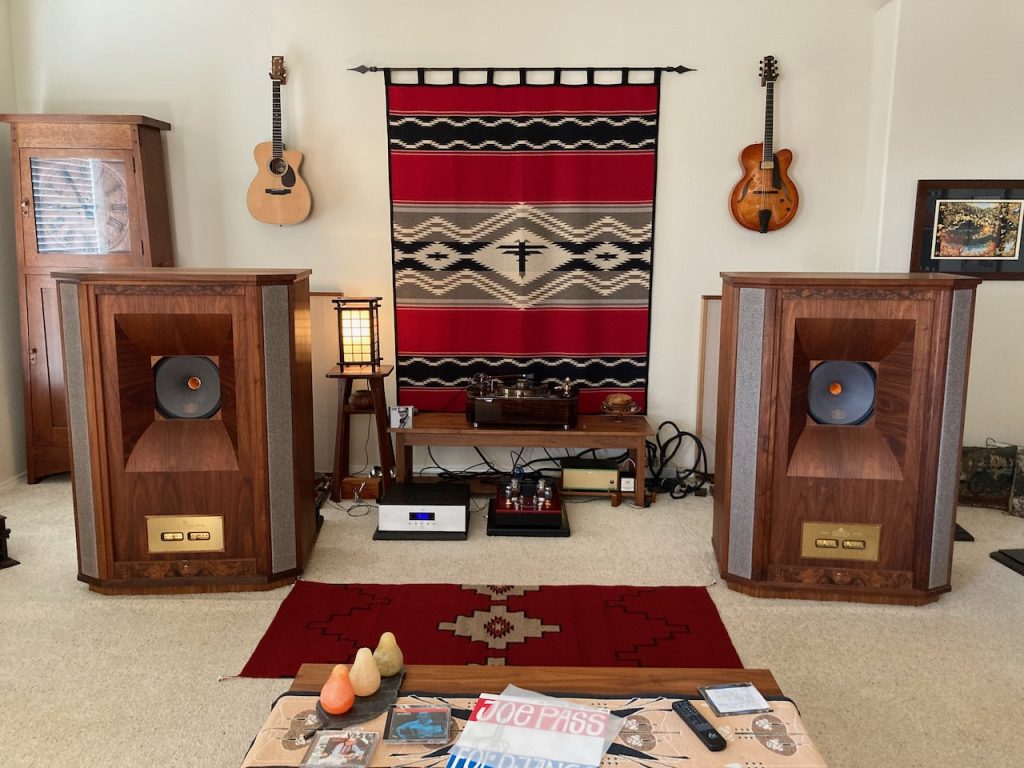
That's why I love integrated amplifiers. The Triode Lab 45 EVO SET integrated amp (above) helps me simplify the setup in my primary music system, and the combined performance with my Westminsters is breathtaking.
The Audio Note (UK) Meishu Phono Silver Tonmeister 300B SET integrated amplifier, and the Audio Note (UK) Oto Phono SE Signature integrated amplifier, combine a preamplifier, amplifier, and phono stage all in one chassis, which makes life easy for getting a system optimized. Simplify.
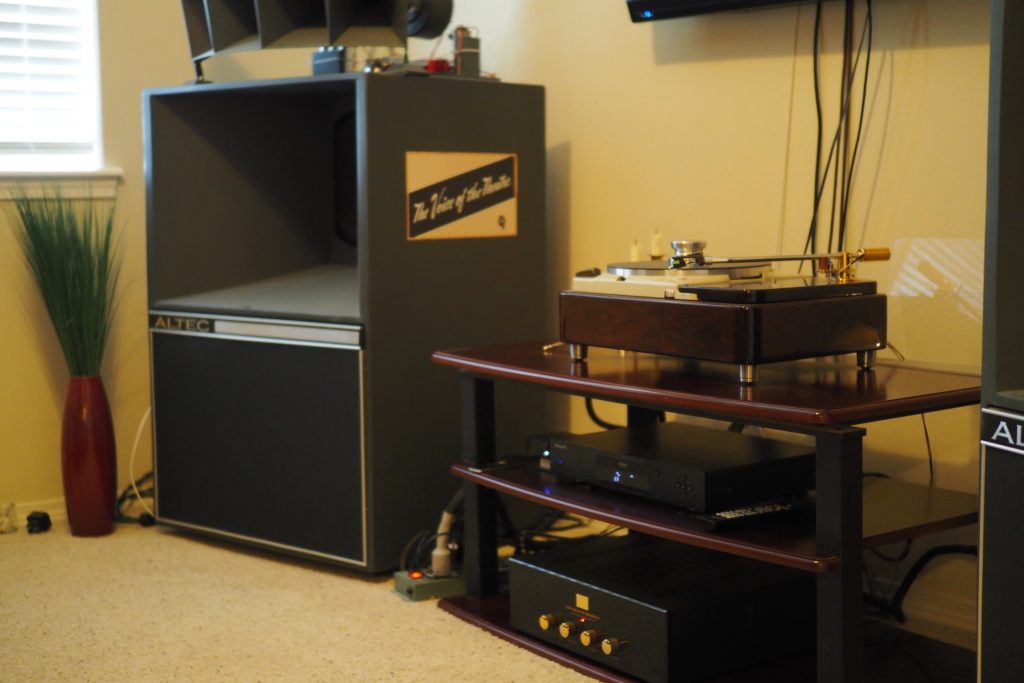
Vintage Altec A5 Voice of the Theatre loudspeakers with Audio Note (UK) Oto Phono SE Signature integrated amplifier.
As another aside, for whatever reason - and at least part of it is they are superb integrated amplifiers to begin with - the Meishu and Oto are magic matches to my vintage Altec loudspeakers.
The sound quality and musicality of the Audio Note (UK) integrated amplifiers in combination with my vintage Altec loudspeakers I find to be wildly impressive and satisfying.
I could be deliriously happy with either the Oto or Meishu integrated amplifiers in combination with any of my vintage Altec loudspeakers as 'forever' amplifiers. Did I mention I love integrated amplifiers? I do.

Vintage Altec A5s with Audio Note (UK) Meishu Phono Silver Tonmeister 300B SET integrated amplifier.
If you want to go for separate a preamplifier, amplifier, and phono stage combination, you'll have a lot better chance of realizing optimum performance if they are from the same manufacturer, as they will be designed to work together well.
Often the worst sounding hifi systems I hear mix and match preamplifier, amplifier, and phono stage components from different manufacturers from audio magazines recommended component lists. You can't just willy nilly put components together from a list of components that a variety of audio writers like and expect a good result, it just doesn't work that way.
Save yourself a headache and choose as many components as possible from the same manufacturer. That will generally give you the best performance, or even easier, simplify and go with a quality integrated amplifier, which I usually enjoy more than separate components anyways.
Also, integrated amplifiers tend to be less expensive than separate components of similar performance, allowing you to free up money that you can invest in higher quality sources or loudspeakers, resulting in higher overall audio system performance.

Audio Note (UK) Io I MC phonograph cartridge.
The same thing applies to digital and analog sources. Choose sources that complement your electronics and loudspeakers, which is a lot easier if they're sources from the same manufacturer as your electronics.
Cables ... speaker cables, interconnects, power cables, etc., all have a large influence on the sound quality and musicality of an audio system or component.
I get so many audio components to write about that choosing the cables to best compliment them can be a real chore.
Fancy audiophile cables also can cost a stupid amount of money, and vary all over the place in voicing, so unless you don't have to worry how much you spend on toys, the reality is you are probably better off spending that money elsewhere in your system, or better yet, building up your music library, or going on a vacation to a country you haven't visited yet.
Silver cables can be great in systems that are designed to be at their optimum with silver cables, but adding silver cables into a system not optimized for them usually degrades sound quality and musicality. At least that's been my experience over the last three or four or so decades.
Copper cables are a safer bet for systems not designed to be at their best with silver cables.
Nine times out of ten, my favorite speaker cables and interconnects for getting an audio system optimized for a nice balance of sound quality and musicality for reviews are tinned-copper cables.
Tinned copper cables are the Swiss Army knife of cables, and they are almost always a good choice for getting an excellent voicing for any given component or audio system.
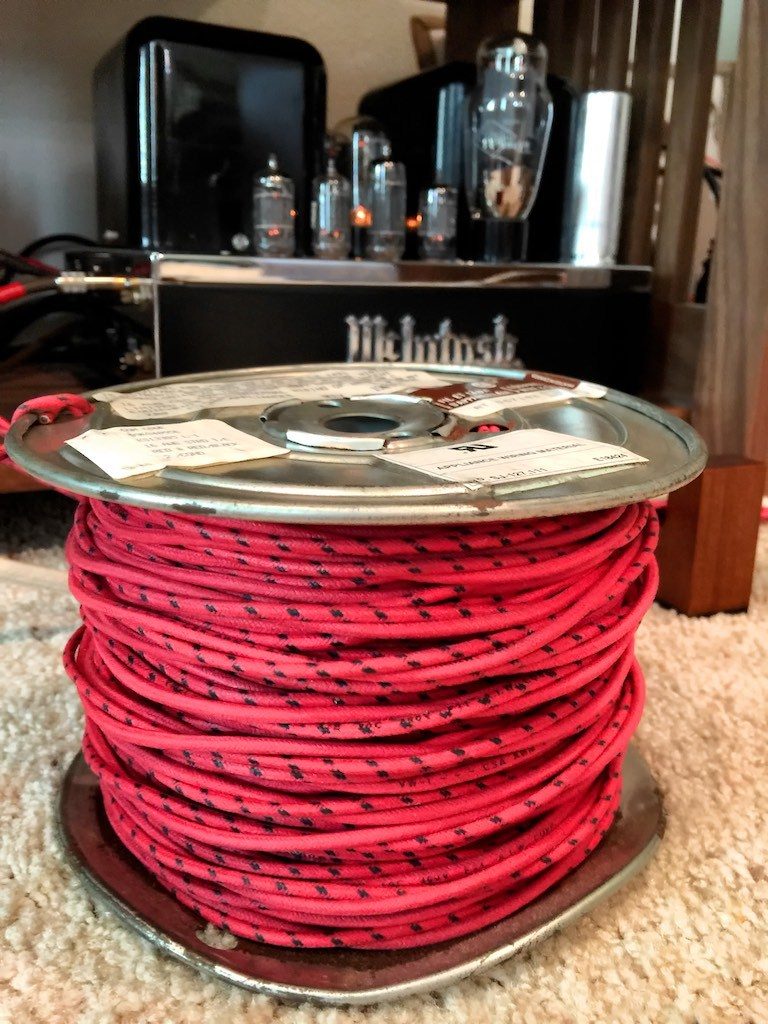
Vintage Western Electric WE16GA tinned-copper wire recommended by Yazaki-san.
Tinned-copper cables have a long history in the hifi, recording, and the music biz, and I find my collection of vintage Western Electric WE16GA cables, and Duelund DCA20GA, DCA16GA, and DCA12GA tinned-copper cables, almost always give me a superior voicing to anything else I've tried over the years.
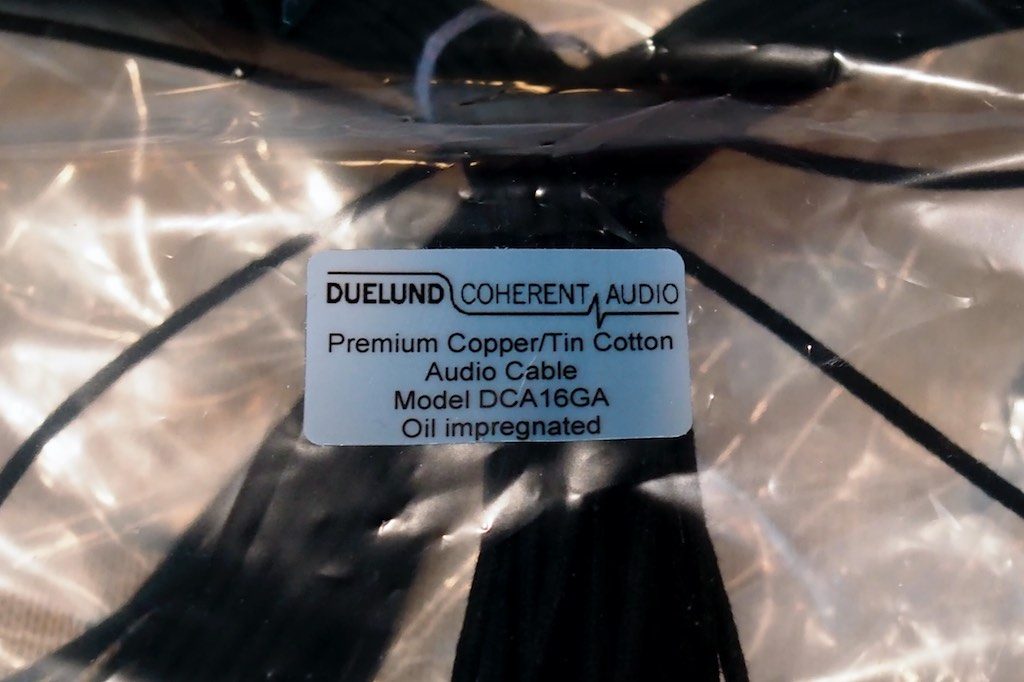
Vintage inspired Duelund DCA16GA tinned-copper wire.
I really like Belden 8402 tinned-copper microphone cable for interconnects too, and I use them in all my audio systems.
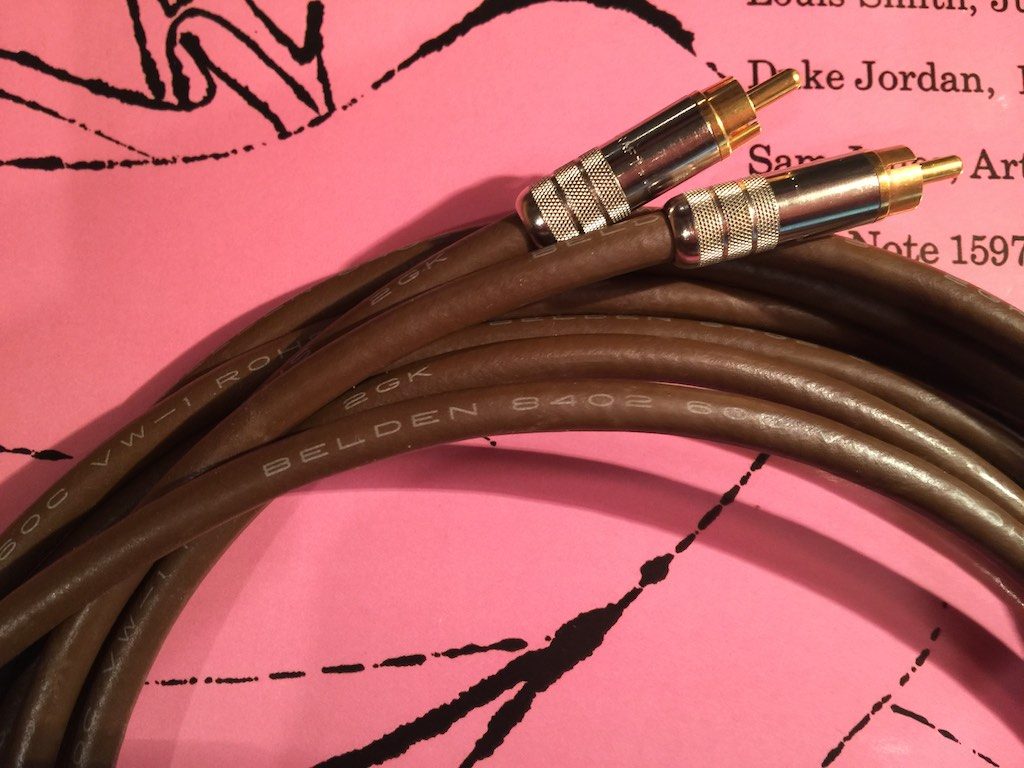
Belden 8402 microphone cable interconnects.
The great thing about tinned-copper cables is they are inexpensive, and they make for a simple DIY project if you've got a soldering iron.
Or you can have Parts Connexion build Duelund speaker cables and interconnects for you, or have Best-Tronics Pro Audio build up Belden 8402 microphone cable interconnects for you. I recommend them both, and there's no reason to spend a ton of money on speaker cables and interconnects to get a high level of cable performance.
I've found quality power cables to make a big difference in amplification electronics and source components performance. A BIG difference. I know, it's hard to wrap my head around that too.
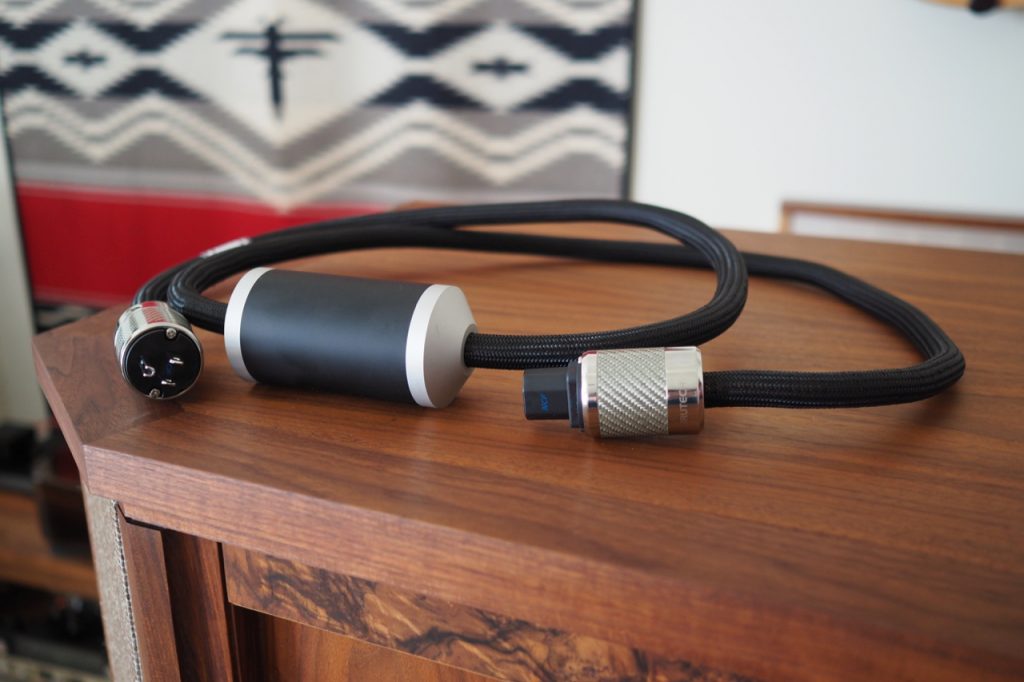
Acoustic Revive Absolute Power Cable
I haven't yet come up with a DIY recipe for power cables that I like better than power cables from Acoustic Revive and Sablon Audio. Those are expensive cables but they work great, and can make a dramatic improvement in sound quality and musicality.
If you can't afford those expensive power cables, don't fret. One of these days someone will come up with a recipe for a budget DIY power cable that will be superb. Wait for it.
Time for listening tips ... what do I listen for?
What I listen for in audio reviewing - and as a music enthusiast - has changed a lot over the years.
As a youngster I didn't care about sound quality, just the music, and I listened around the sound quality flaws of my generic 'off the rack' audio systems, and in spite of lousy audio equipment, I still enjoyed the music.
Then I began to read audiophile magazines that focused on maximizing visuospatial recording cues that are present in magnetic era stereo recordings.
I became aware of traits like imaging, soundstage, resolution, and so forth, all the typical audiophile vocabulary jargon.
So I built audio systems using audiophile-style components that reviewed well in audiophile magazines, and was usually very disappointed with the way they played music.
Eventually it dawned on me there was a great flaw in the usual focus of the audiophile vocabulary, particularly for reviewing audio components, as it didn't really address how well audio equipment played music.
That focus on visuospatial performance seems rather bizarre when you think about it, since listening to music is what the audio hobby is about, not listening to recording artifacts.
Over the years I came across people with similar perceptions and tastes to mine. The much missed late Art Dudley was one, as well as a number of the individuals who wrote for his Listener magazine.
Over time I learned more about single-ended-triode amplifiers, horn loaded loudspeakers, vintage components, Garrard turntables, Thorens turntables, SPU phono cartridges, etc., in the vintage world of audio components.
Many of these vintage (or neo-vintage) audio components not only sounded good from an audiophile perspective, but they also played music very well too, something that much of the mainstream audiophile world had lost the ability to do in its silly pursuit of maximizing visuospatial recording cues in audio playback.
So that's the sort of audio components I gravitated towards. Vacuum tube electronics, turntables for playing records, horn loudspeakers, and tinned-copper cables. A vintage inspired approach to audio.
I would eventually come across exceptions to those vacuum tube components, vinyl, and horn loudspeakers, that I really liked, like the Pass Labs and First Watt solid-state components, and the Spec Class D components, for example.
Fast forward in time to 2019. I visited Peter Qvortrup (Audio Note (UK)) in Brighton, England, and discovered a kindred spirit.
More importantly, Peter introduced to me the idea that an audio system should be able to play music recorded during the acoustic (1877 to 1925), electric (1925 to 1945), magnetic (1945 to 1975), and digital (1975 to now) eras of the recording arts equally well.
Until meeting Peter, I had not considered that it was even possible to achieve exceptional music playback from any quality of recordings of music from low-fidelity to high-fidelity, but the revelation of that being achievable opened up a new world of music listening to me, and a new way of thinking about voicing audio systems.
First of all, I don't get serious about listening until components or audio systems are fully run-in. Once everything is fully run-in, then its time to start getting the system setup optimized for the best combination of sound quality and musicality that system is capable of.
I am a listener that enjoys music from all the eras of the recording arts, whether they are low-fidelity or high-fidelity, and I enjoy a system that can play back all those recordings with a high degree of musical engagement.
I recommend that you ask yourself, “What kind of listener am I?”
Some listen only to recordings of the finest quality, while some listen only to recordings of the finest musical performances, and some are musical explorers who enjoy listening to all the varied music from our immense recorded music canon.
Audio engineers build audio equipment with various “voicings”, to accommodate different kinds of listeners, so those different listeners can get the most out of the music they enjoy listening to.
Audio equipment voiced for those who listen to only recordings of the finest quality, are typically optimized to play back the best recordings from the magnetic (stereo) and digital eras of recording, in the finest sound quality possible.
The downside of those style of audio systems is they typically don't play back recordings from the acoustic, electric, and mono period of magnetic recordings very well, and can often sound quite unpleasant on recordings from those eras.
Audio equipment voiced for those who wish to explore music from all of our recorded music canon - the acoustic, electric, magnetic, and digital eras of recording - allows listeners to enjoyably listen to a wide range of recordings of varied recording quality, while minimizing sound quality issues of lower fidelity recordings, and still presenting high-fidelity recordings in all their glory.
When you are out auditioning equipment at audio fests or audio dealers, ask yourself, “What kind of audio system am I listening to?”
Identifying the type of audio system you are listening to will help you understand how to 'review' it, and what music to use for your ‘review’.
To learn more about the performance of the audio systems I listen to as a reviewer, I use examples of my favorite music that spans the range of low-fidelity to high-fidelity recordings from the four eras of the recording arts.
As I listen, I jot down notes mentally, or on paper, about what I hear and feel about a component's or system's performance.
What you notice about an audio system’s performance will tell you a lot about the design focus of the audio system you are listening to, what your personal tastes are as a listener, and what will make for good additions to your own audio system to maximize your listening enjoyment.
Audiophiles typically like to listen to high-fidelity stereo recordings from the magnetic and digital eras of recording, and they enjoy exploring the visuospatial aspects of recordings from those eras.
Be an audiophile for a day and ask yourself how well the audio system you are listening to portrays the non-musical visuospatial characteristics of recordings.
For example, when I am reviewing a component I listen for audiophile performance metrics using high-fidelity stereo recordings from the magnetic and digital eras of the recording arts so I can report on those metrics for those who are interested in them.
Do I like what I hear in terms of the soundstage (the three dimensions of the recorded space in width, height and depth), the imaging (the ability to localize instruments & musicians on the soundstage), transparency (the ability to ‘see’ aurally into the recording), and the resolution (the amount of detail in the audio signal that is audibly presented)?
Next I ask myself how musically natural an audio systems sounds with those high-fidelity recordings.
Does it sound musically natural like the live music I listen to?
I then ask myself if I hear a sense of realistic instrumental timbre (the unique ‘voices’ of instruments), the resolution of tone color (the ability to distinctly hear the chordal variations resulting from adding additional pitches to three tone triads), melody (the tune you ‘whistle while you work’), harmony (treble & bass accompaniments to the melody), rhythm (the steady beat that determines the tempo), tempo (speed), dynamics (variations in loudness), and loudness (the ability to play naturally at live-like levels appropriate to a piece of music)?
If an audio system doesn’t sound musically natural to me, I ask myself why not. Is it because it sounds overly electronic, synthetic, or even amusical?
Or is there just something else about the way it plays music that is a distraction from an enjoyable music listening experience?
Maybe the presence region has been goosed up? Maybe the bass booms? Maybe there is too much or too little resolution?
I also ask myself, “How well does this audio system communicate the emotional and artistic content of the music?”
I focus on how the way the audio system plays music makes me feel. Do I get lost in the artistic 'feeling' of the music, or am I distracted from the listening experience by the nature of the sound quality issues of an audio system?
Many of the greatest musical performances recorded in our historic music canon reside in the monaural recordings from the acoustic, electric, and early magnetic era of recordings, so for me those recordings are an important test of an audio system's mettle.
In monaural recordings, visuospatial cues like soundstage and imaging are greatly reduced, if they exist at all, so for those recordings I listen primarily for how well the audio system conveys the quality of the musical performances, regardless of their early lower-fidelity recording quality.
I ask myself if the tonal balance of the audio system I am reviewing allows me to enjoy those early recordings of musical performances without distraction.
Or does the system's tonal balance distract me from the listening experience by emphasizing sound quality issues of lower-fidelity recordings that make them less enjoyable to listen to?
Finally, I ask myself if the audio system I am ‘reviewing’ gives me a sense of the ‘authenticity' for each of the eras of the recordings arts, while still allowing me to fully enjoy the musical performances from each of those recording eras.
Personally, I want a system that can get the best out of recorded musical performances from all the eras of the recording arts, and can provide me with an emotionally engaging listening experience, while still preserving the 'authenticity' of the original recording in a 'time-travel' sort of way.
I find that listening for the different aspects of audio system performance that I've mentioned above tells me a lot about what my own personal listening preferences are, and what I really value in home audio system performance.
I recommend that as you listen to an audio system, that you let your listening notes be your guide to discovering what your listening preferences are, as well as what sort of audio system or components will make you the happiest listener over the longer term.
Other Practical Considerations
The audio hobby is a wonderful pastime.
Music is a wondrous art form, an essential weave in the colorful fabrics of our cultures that helps give meaning to our lives.
Music is an artistic gift from musicians to us all. A gift that allows us to experience beauty, love, loss, joy, tragedy, and many other emotions, as expressed in music.
Music stirs us to dance in joyful abandon, aids us in expressing meaning through our rituals, and evokes fond memories from times past. Music makes our world a more meaningful and beautiful place to live.
Listening to music brings many benefits. Music can improve our mood, reduce our stress, soothe our worries, ease our pain, and provide us a comforting distraction in a discomfiting world.
Prior to the appearance of the recording arts on Planet Earth, if one wanted to enjoy music it meant attending a live musical performance, or singing and playing one’s own music.
With the advent of the recording arts, we are fortunate that we now have a vast recorded music canon that spans the acoustic (1877–1925), electric (1925–1945), magnetic (1945–1975), and digital (1975–present) eras of recording, available for us to listen to and enjoy.
Recordings of musical performances are to music what Ansel Adams' photographs are to the landscapes of the American West, unique artistic documents of a musical performance captured at a moment in time by those in the recording arts.
Recordings are “musical photographs” that allow the many to experience and enjoy the musical performances, instead of only the few that are present at live performances.
Our love for music is what got many of us interested in audio. Listening to our favorite recordings of music is a treasured activity that bathes our entire being in the beauty and wonder that is music.
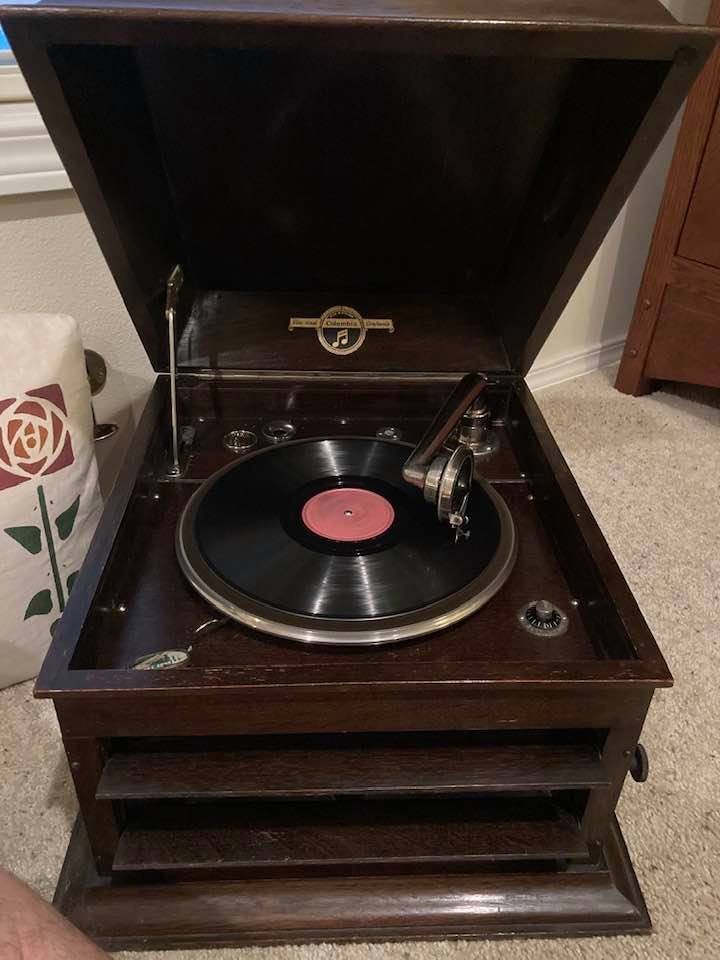
My 100 year old gramophone.
Home music listening has paralleled the evolution of the recording and cinema arts. During the acoustic era of recording we listened to our gramophones and 78 records (above), and with the advent of radio broadcasting in the electric era of recording, we began listening to music as part of radio broadcasts over our home radios.

Vintage tabletop vacuum tube radio.
The introduction of condenser microphones, vacuum tube amplifiers, and electromagnetic cutting heads during the electric recording era brought improved sound quality to us, and when sound recording was synchronized with motion pictures in the late 1920s, film industry research & development delivered major improvements to the audio reproduction chain, with amplification quality improving rapidly from 1920 to 1930, and loudspeaker quality improving rapidly into the late 1930s.
The sound quality of the recording arts improved significantly going from the electric to the magnetic era in 1945, and the recording arts evolved rapidly during the magnetic era, first with monaural recordings, then stereo recordings, and then multichannel recordings.
Upon entering the digital era of recording, software and audio equipment has continued to diversify at a rapid pace, and we now have a great variety audio equipment designed to please every listener and budget.
There are some practical considerations for maximizing your personal enjoyment in the audio hobby.
You really need to understand what will best serve you as a listener, and what you like or dislike about audio system performance.
Are you an audiophile that only listens to high-fidelity magnetic era stereo recordings? What you like in an audio system may be very different than the person that wants to listen to a wide range of recordings that span the different eras of the recording arts.
If you want to listen to a wide range of recordings that span the different eras of the recording arts, the audio system that will be best for you will likely be quite different from that of an audiophile who listens only to high-fidelity magnetic era stereo recordings.
Know thyself, and know that it is ok to like what you like.
An important consideration is where you will be listening to music. A lot of the population of Planet Earth lives in smaller spaces, rather than the enormous listening spaces some audiophiles have.
If you live in a smaller space, the best system for you will likely be with loudspeakers designed to provide high-performance in room boundary positions (room corners or up close to the front wall), that free up as much living space as possible.
Then there's considerations about the cost of purchasing an audio system. The good news is that these days there are high-performance audio systems for almost every budget, and the days of having to spend as much for an audio system as for a Ferrari Evo to get high-performance are long gone.
Another consideration is the long term reliability and maintenance costs of an audio system. Vacuum tube audio systems are terrific, but they require ongoing maintenance costs to replace tubes as they age, and depending on the type of vacuum tubes, those costs can range from insignificant to breathtakingly expensive.
Solid-state equipment from companies like First Watt and Pass Labs provide leading-edge audio performance, are completely reliable, and have zero maintenance costs except for the electricity they consume. If you want to minimize long term costs of ownership, solid state electronics may be for you.
Another consideration for vacuum tube components is if they use tube types, or other vintage parts, that are no longer produced.
Eventually the new old stock supply of out of production vacuum tubes or vintage parts will be depleted, and your cherished component will no longer be serviceable.
You'll be the proud owner of a non-functional audio brick. If you have money to burn that may not be a factor, but if cost is a consideration then look to components that have readily replaceable current production components and vacuum tubes.
Overall Journey
I've immensely enjoyed my audio journey over the decades, and it has brought a lot of personal satisfaction to my life.
I really enjoy listening to recordings of great music from all of the eras of the recordings arts that make up our historic recorded music canon, and having various types of audio systems in my home.
I've had a blast listening to music and watching films with vintage audio equipment, and modern audio equipment.
I've enjoyed my gigantic horn-loaded loudspeakers, as well as more modern monitor-sized loudspeakers.
I'm fascinated both by high-performing vacuum tube electronics and solid-state electronics.
I'm thankful for quality vinyl front ends, and for the versatility of digital sources.
I've loved my forays in to the DIY world of audio, and am impressed with what's possible to achieve for the DIY hobbyist.
I'm thankful for all the wonderful people I've met through my audio hobby. For audio friends, for you, dear readers, who I truly enjoy writing about audio for and hearing from, and for the designers and creative forces that shape our hobby.
All of you have expanded my understanding of what is possible in audio in a very illuminating way.
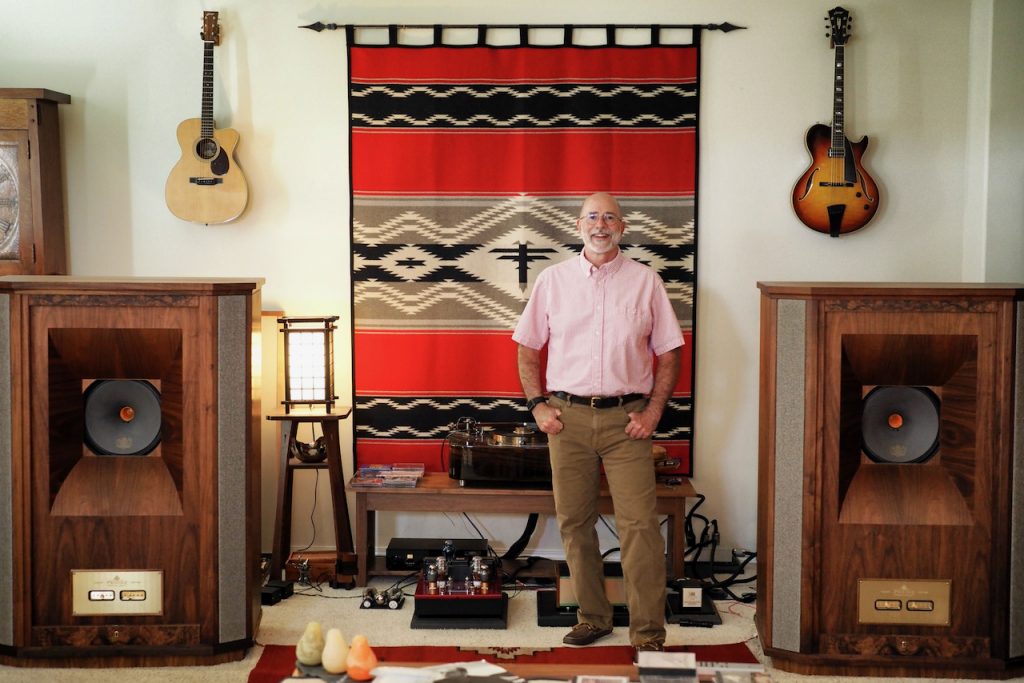
Thank you all for joining me in this crazy audio hobby over the years, its been quite a wonderful experience!
I hope this little overview of my experiences in the audio hobby over the years has provided you with a few ideas that will help you to maximize your own music listening enjoyment.
As always, thanks for stopping by, and may the tone be with you!



























